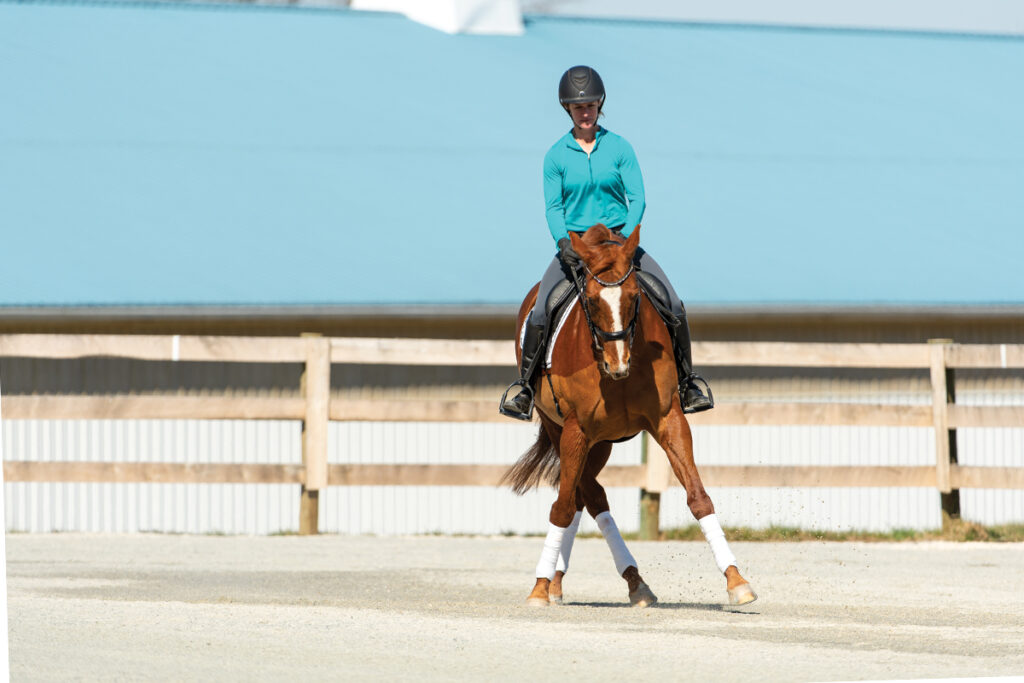Last month I discussed how the leg-yield is a useful suppling and training tool for both horse and rider, how the movement is ridden, and some of the common mistakes from the rider’s point of view. Of course, the horse can cause leg yield errors, too, and this article will focus on some of those and how to correct them.

When you first work on the leg-yield, your expectations should coincide with your horse’s level of experience. Initially, I look for the horse to grasp the concept that I am asking him to move sideways in a steady rhythm. The elements of more leg crossing, connection, and straightness will all become more refined with time.
Troubleshooting Leg Yield Errors
Here are four common errors you will face with your horse if you’re just beginning to work on the leg-yield, and how to fix them.
Error No. 1: The horse rushes off when you squeeze your inside leg. An exercise that is helpful for this problem is to begin the leg-yield, and the moment your horse begins to rush, start a circle in the opposite direction of the movement. Return back to the line you left from and proceed on with the leg-yield.

For example, if you are leg-yielding left from the centerline (away from your right leg) and your horse begins to rush near the quarterline, turn right onto a 15-meter circle to help rebalance him and then return back to quarterline and proceed straight with the leg-yield again.
Error No. 2: Your horse won’t move sideways. I like to teach as much from the ground as I can so that it translates easily to the horse under saddle. One in-hand exercise I use to teach the leg-yield is the turn on the forehand while keeping the horse straight through his body.
If your horse is still struggling under saddle when first being asked to leg-yield, providing him with an opening outside rein and slightly shifting your weight in the direction of the movement will guide him over. As your horse begins to connect the push of your inside leg with moving over, you can begin to stay more neutral in your stirrups and keep the outside rein toward your horse’s shoulder to build the leg-yield straighter and straighter.
Error No. 3: Your horse comes off the bit. This is commonly due to a loss of balance. When a horse is first learning to leg-yield, I don’t get flustered if the connection doesn’t stay consistent the entire time.

The leg-yield is used to improve connection from inside leg to outside rein, creating a more rounded connection over your horse’s back. As he gets stronger and improves in the exercise, the connection will also improve.
One thing you need to be sure of is that you don’t automatically begin pulling back on the reins to “wrestle” your horse’s head back down. This leads to tension in his back and loss of control of his hind end.
Instead, be sure to offer a rebalancing half-halt on the outside rein, keeping a slight flexion away from the direction of the leg-yield, and trust that the issue of the connection in the front will be fixed by your horse coming more underneath you with his inside hind.
Always be sure to soften the rein pressure as your horse begins to relax down into the bit as a reward and reassurance to him that he is doing what you’ve asked.
The Leg-Yield DefinedThe horse is almost straight, except for slight flexion at the poll away from the direction in which he moves, so that the rider is just able to see the eyebrow and nostril on the inside. The inside legs pass and cross in front of the outside legs. Leg-yielding can be performed on the diagonal, in which case the horse should be as close as possible parallel to the long sides of the arena, although the forehand should be slightly in advance of the quarters. It can also be performed along the wall, in which case the horse should be at an angle of about 35 degrees to the direction in which the horse is moving. |
Error No. 4: Your horse will not cross his legs. For this, I use the “head to the wall” leg-yield exercise. Beginning in the walk, travel straight through the short side and cut the second corner on a diagonal toward the wall. I tell my students to pretend they are going to ride out of the arena on a diagonal line.

As your horse’s head comes to the wall, keep his neck straight and send him away from what was your outside leg. For example, if you are tracking right, you would be sending your horse sideways from your left leg. Be sure to keep his body on that same diagonal line, around a 30- to 35-degree angle, and not swinging straight back to the wall or perpendicular to it. This is also a useful exercise for the horse who has a tendency to rush through the leg-yield.
When ridden correctly, the leg-yield establishes a better connection from inside leg to outside rein and helps to supple the horse through his hips, croup, lower back and shoulders. Ultimately, it will improve overall balance, which is important for keeping you and your horse working in harmony.
This article about how to fix leg yield errors appeared in the June 2021 issue of Horse Illustrated magazine. Click here to subscribe!






